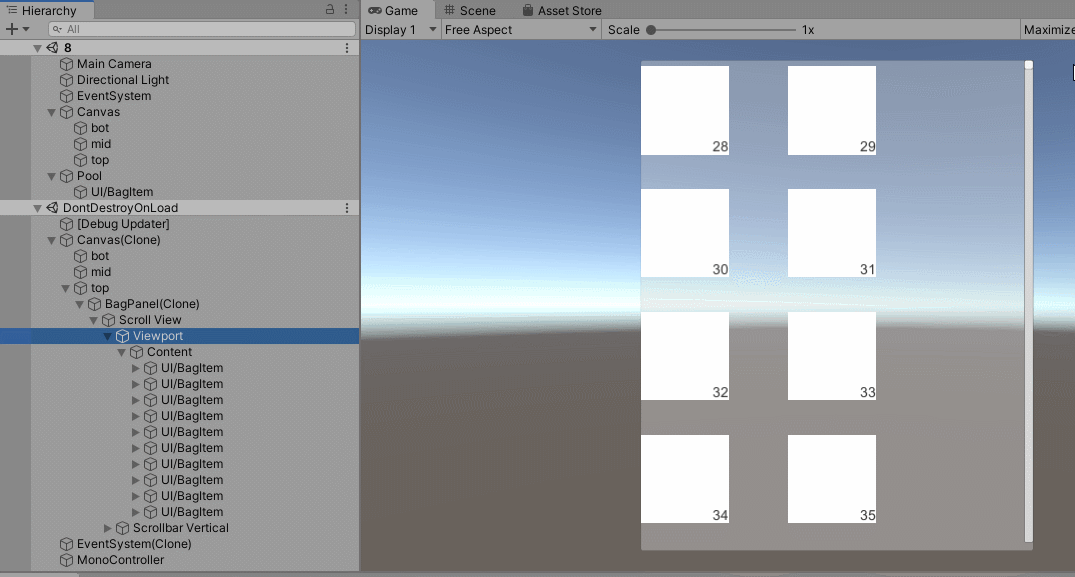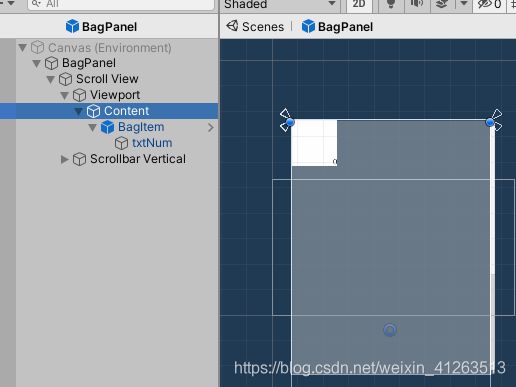【U3D/UGUI】5.优化滚动panel(10w个物品)并泛化
自我介绍
广东双非一本的大三小白,计科专业,想在制作毕设前夯实基础,毕设做出一款属于自己的游戏!
优化滚动panel
理论基础:
- 背包中显示(可视范围内)有多少个物品就有多少个gameobject
- 利用位置关系计算并显示出当前格子信息
效果如下:
要用到前面的UI框架和单例
搭建场景
非常简单,背包面板只是一个简单的 ScrowView,做成预制体
当背包里的格子也要做成预制体,格子身上也应该要挂载一个类主要用于初始化信息(后期扩展可以鼠标移上去展示信息),这里的格子只有简单的数字当下标
格子主要放在Content里面
处理格子
每个格子都有基本的信息,我们抽象出一个简单的model
Item.cs
public class Item
{
// 道具信息
public int id;
public int num;
}
格子信息有了,怎么让他展示在UI上呢,我们先抽象出一个接口供给UIItem必须继承的(抽象出接口是以后有用的)
IItemBase.cs
public interface IItemBase<T>
{
// 该接口 作为 格子对象 必须继承的类 它用于实现初始化格子的方法
void InitInfo(T info);
}
要明确:
- 每个格子都是一个UI,所以要继承前面UI框架里的 BasePanel
- 每个格子必须实现接口 IItemBase
现在开始实现格子类
BagItem.cs
using UnityEngine.UI;
/// ScrowView通用类
格子有了,现在做背包,但是不只是背包,其实很多地方都有需要用到
所以先抽象出通用的一个 类(除了背包,计分板也有可能要用到)
CustomSV.cs
using System.Collections.Generic;
using UnityEngine;
/// 代表的 数据来源类
/// 代表的 格子类
public class CustomSV<T, K> where K : IItemBase<T>
{
private RectTransform content; //履带对象 需要通过他得到可视范围的位置 还要把动态创建的格子设置为他的子对象
private int viewPortH; //可视范围高
private Dictionary<int, GameObject> nowShowItems = new Dictionary<int, GameObject>(); //当前显示着的格子对象
private List<T> items; //数据来源
//记录上一次显示的索引范围
private int oldMinIndex = -1;
private int oldMaxIndex = -1;
//格子的间隔宽高
private int itemW;
private int itemH;
private int col; //格子的列数
private string itemResName; //预设体资源的路径
//初始化工作可以放到构造函数内,不过要注意调用顺序
// 初始化格子资源路径
public void InitItemResName(string name)
{
itemResName = name;
}
/// 上面最重要的还是CheckShowOrHide方法
背包管理器
下面涉及背包部份,一个背包需要有个背包管理器,主要用来初始化物品信息
BagMgr.cs
using System.Collections.Generic;
/// 背包面板
毕竟背包是显示给人看的,所以需要有个背包面板 里面用到上面我们提到的通用类
BagPanel.cs
using System.Collections;
using UnityEngine;
/// 如果觉得放到Update里面执行CheckShowOrHide方法有点浪费的话
可以另外暴露一个新方法提供给ScrowView里的监听 OnValueChange 事件
最后只需要把 BagItem 脚本拖拽到 对应的预制体,把 BagPanel 脚本拖拽到对应的预制体上即可使用

